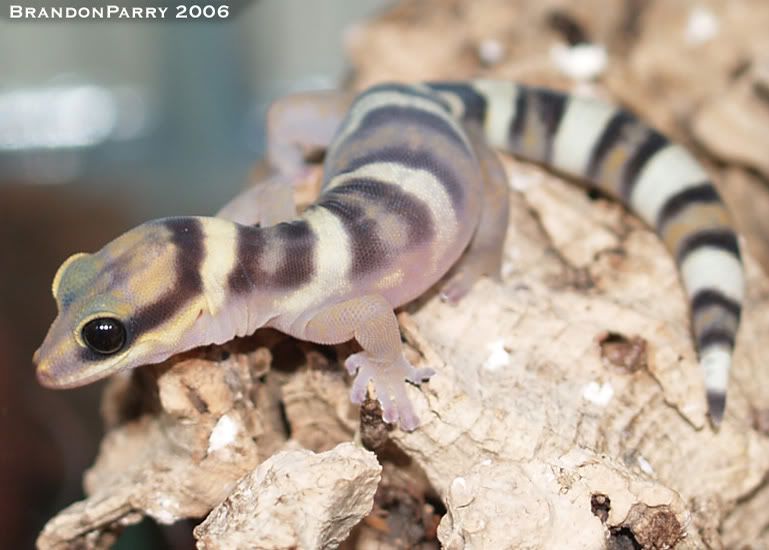Brandon Parry
New member
Oedura marmorata

DESCRIPTION
Has a snout to vent length of roughly 4.25-4.5 inches with an overall length of around 7-7.25 inches. Tail size can vary between locales from slender, plump, depressed to beaver tail shaped. Most specimen are purplish brown with roughly 6 pale bands broken up by dark brown to black spacing with yellow highlights and spotting. Belly is white or creamish color and limbs are without bands.
DISTRIBUTION
Can be found in rock outcroppings, this species is semi arboreal and will retreat and seek shelter in rock crevices. Located in Queensland, New South Whales, Northern Territory, and parts of Western Australia
COMMON NAMES
Marbled velvet gecko. Australian velvet gecko, Australian marbled velvet gecko
DIET
Diet consists of appropriate sized insects and invertebrates. In captivity crickets make up the main staple of the diet.
CAPTIVE CARE AND HOUSING
Adults or pairs can be kept in a 20" wide 10" deep 12" high terrarium. Substrate should consist of an even mix of sand and either soil or compressed coco fiber. No UV lighting is needed since this species is nocturnal but it will not hurt and can help to keep the animal in a routine along with a timer set for 12-14 hours of light. Heating should be supplied via either an under tank heater or an incandescent bulb usually a 15-25 watt bulb will suffice depending on the rooms ambient temp. The cage temp should be in the mid 80's with a hot spot in the mid 90's. Stacked slate should be added to the cage along with some sterilized bark for cage furniture. Make sure the slate is stacked in a manner so that the animal will not get crushed if it is shifted or gets moved. Hatchlings and juveniles can be kept in a similar manner but scaled down, or can be housed in a simplistic setup with paper towels and paper towel tubes. Feeding should take place daily, appropriate sized food should be supplied and supplemented with a calcium based formula with D3. Water is supplied via misting once every other day, this species is a dry forest species so the terrarium should not constantly be moist.
BREEDING
Marmoratas will bury there eggs so a nesting site should be supplied, a nice sized butter tub with a hole cut in the lid and filled with soil works great. Females will retreat to the tub and will burrow and lay there eggs in the soil. Once eggs are found they should be placed in a deli cup with some sort of incubation medium. Incubation temps can very from 80-88 degrees. Eggs if incubated properly should hatch within 60-90 days.
Brandon Parry 2006

DESCRIPTION
Has a snout to vent length of roughly 4.25-4.5 inches with an overall length of around 7-7.25 inches. Tail size can vary between locales from slender, plump, depressed to beaver tail shaped. Most specimen are purplish brown with roughly 6 pale bands broken up by dark brown to black spacing with yellow highlights and spotting. Belly is white or creamish color and limbs are without bands.
DISTRIBUTION
Can be found in rock outcroppings, this species is semi arboreal and will retreat and seek shelter in rock crevices. Located in Queensland, New South Whales, Northern Territory, and parts of Western Australia
COMMON NAMES
Marbled velvet gecko. Australian velvet gecko, Australian marbled velvet gecko
DIET
Diet consists of appropriate sized insects and invertebrates. In captivity crickets make up the main staple of the diet.
CAPTIVE CARE AND HOUSING
Adults or pairs can be kept in a 20" wide 10" deep 12" high terrarium. Substrate should consist of an even mix of sand and either soil or compressed coco fiber. No UV lighting is needed since this species is nocturnal but it will not hurt and can help to keep the animal in a routine along with a timer set for 12-14 hours of light. Heating should be supplied via either an under tank heater or an incandescent bulb usually a 15-25 watt bulb will suffice depending on the rooms ambient temp. The cage temp should be in the mid 80's with a hot spot in the mid 90's. Stacked slate should be added to the cage along with some sterilized bark for cage furniture. Make sure the slate is stacked in a manner so that the animal will not get crushed if it is shifted or gets moved. Hatchlings and juveniles can be kept in a similar manner but scaled down, or can be housed in a simplistic setup with paper towels and paper towel tubes. Feeding should take place daily, appropriate sized food should be supplied and supplemented with a calcium based formula with D3. Water is supplied via misting once every other day, this species is a dry forest species so the terrarium should not constantly be moist.
BREEDING
Marmoratas will bury there eggs so a nesting site should be supplied, a nice sized butter tub with a hole cut in the lid and filled with soil works great. Females will retreat to the tub and will burrow and lay there eggs in the soil. Once eggs are found they should be placed in a deli cup with some sort of incubation medium. Incubation temps can very from 80-88 degrees. Eggs if incubated properly should hatch within 60-90 days.
Brandon Parry 2006

